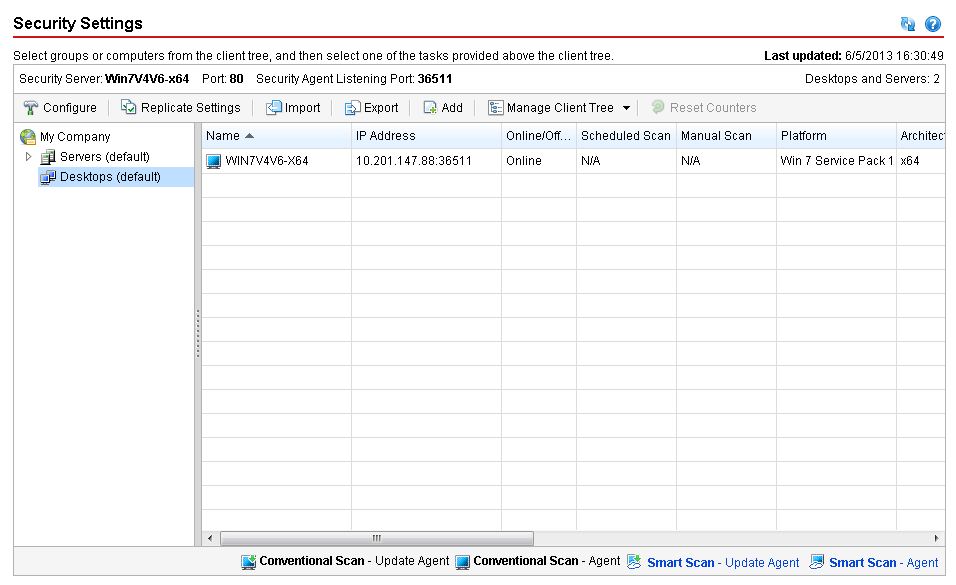In Worry-Free Business Security, groups are a collection of agents that share the same configuration and run the same tasks. Organize agents into groups in the Security Settings screen so you can simultaneously configure and manage them.
Security Groups Tree and Agents List

In the Security Settings screen, groups appear under the Security Groups Tree section on the left side. For ease of management, create groups that represent departments or functions in your company. You can also create special groups. For example, create a group that includes Security Agents on clients that are at a greater risk of infection so you can apply stricter security policies and settings to the group.
When you click a group, the agents that belong to that group display in the Agents List to the right.
Agents List Columns
The columns in the Agents List show the following information for each agent:
Red-shaded cells in the Agents List contain information that requires your attention.
Column |
Information Shown |
|---|---|
For Security Agents |
|
Name |
Host name of the client where the agent is installed |
IP Address |
IP address of the client where the agent is installed |
Online/Offline |
|
Scheduled Scan |
Date and time of the last Scheduled Scan |
Manual Scan |
Date and time of the last Manual Scan |
Platform |
Operating system of the client where the agent is installed |
Architecture |
|
Scan Method |
For details, see Scan Methods. |
Virus Engine |
Virus Scan Engine version |
Smart Scan Agent Pattern Note:
This column only displays if the scan method is smart scan. |
Smart Scan Agent Pattern version |
Smart Scan Service Note:
This column only displays if the scan method is smart scan. |
|
Virus Pattern Note:
This column only displays if the scan method is conventional scan. |
Virus Pattern version |
Viruses Detected |
Number of viruses/malware detected |
Spyware Detected |
Number of spyware/grayware detected |
Version |
Version of the agent |
URLs Violated |
Number of prohibited URLs accessed |
Spam Detected |
Number of spam email messages |
POP3 Scan |
|
For Messaging Security Agents (Advanced only) |
|
Name |
Host name of the client where the agent is installed |
IP Address |
IP address of the client where the agent is installed |
Online/Offline |
|
Platform |
Operating system of the client where the agent is installed |
Architecture |
|
Exchange Version |
Microsoft Exchange server version |
Virus Pattern |
Virus Pattern version |
Virus Engine |
Virus Scan Engine version |
Version |
Version of the agent |
Tasks for Groups and Agents
Run tasks on a group or one or several agents.
Running a task involves two steps:
Select a target.
Click the button for the task.
The following table lists the tasks that you can perform.
Task |
Target |
Description |
|---|---|---|
Configure |
One Security Agent group (desktop or server) |
Configure the following basic security settings for all Security Agents belonging to the selected group:
|
Configure |
One Messaging Security Agent (Advanced only) |
Configure the following basic security settings for the selected Messaging Security Agent:
|
Replicate Settings |
One Security Agent group (desktop or server) |
The settings of the selected group will be applied by another group of the same type (desktop group or server group). For details, see Replicating Settings. |
Import |
One Security Agent group (desktop or server) |
Import the settings of a source group to the selected target group. Before importing, be sure that you have exported the settings of the source group to a file. For details, see Importing and Exporting the Settings of Security Agent Groups. |
Export |
One Security Agent group (desktop or server) |
Export the settings of the selected target group to a file. Perform this task to back up the settings or to import them to another group. For details, see Importing and Exporting the Settings of Security Agent Groups. |
Add Group |
Security Groups Tree ( |
Add a new Security Agent group (desktop or server group). For details, see Adding Groups. |
Add |
Security Groups Tree ( |
Install one of the following:
For details, see Adding Agents to Groups. |
Remove |
One Security Agent group (desktop or server) |
Remove the selected group from the Security Groups Tree. Be sure that the group does not have any agents or the group will not be deleted. For details, see Removing Agents. |
One or several Security Agents belonging to a group |
You have two options:
For details, see Removing Agents. |
|
One Messaging Security Agent (Advanced only) |
You have two options:
For details, see Removing Agents. |
|
Move |
One or several Security Agents belonging to a group |
Move the selected Security Agents to another group or to another Security Server. For details, see Moving Agents. |
Reset Counters |
Security Groups Tree ( |
Resets threat counts on all Security Agents to zero. In particular, values under the following columns in the Agents List will be reset:
|

